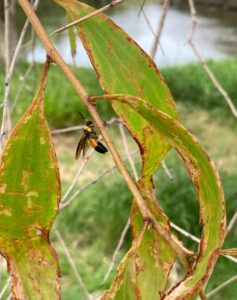Anyone following the bike-track or other footpaths along the Aitkenvale bank of Ross River in recent weeks could hardly fail to notice the stressed appearance of the paperbarks (Melaleuca leucadendra) in the area immediately upstream from the Bush Garden. At first glance a number of the trees appear dead or dying, having been completely defoliated; others have lost most of their foliage. In one or two trees the only green comes from bunches of mistletoe – but this is clearly not the cause.
While we considered several theories – including myrtle rust (heaven forbid) or deliberate poisoning (unlikely, given the location and number of the affected trees) – the most probable cause seemed to be some kind of insect attack. Sarah, a local resident and friend of the Branch, noticed the large number of holes that seemed to pepper the trunks and branches of these trees compared to those that were still in good shape. A few days later she found the trees were covered with winged insects and took photographs which allowed identification.
We believe the ‘culprit’ to be a species of sawfly, Lophyrotoma zonalis, which aptly bears the common name of Melaleuca sawfly. Despite its colour and general appearance it is not a wasp although wasps and sawflies have a common ancestry. Sawflies belong to the same order (Hymenoptera) as wasps, ants and bees but are in a separate sub-order, the Symphyta.
The insects take their name from the saw-like structure of the female’s ovipositor, with which she cuts into the leaves of the chosen tree – and, for this species of sawfly, that’s always a Melaleuca. The eggs are then inserted into this cut. When hatched, the larvae feast on the host plant before burrowing into the tree’s soft bark to pupate, eventually emerging as the colourful adults. Colourful or not, the adult’s life is brief, lasting for not much longer than a week. The adults of many sawfly species do not feed during this time, their purpose being to re-start the cycle by mating and inserting their own eggs in the leaves of another unfortunate tree.
Such large-scale defoliation, and the creation of dozens of pupal chambers under the bark, creates a real challenge for the trees. It is no wonder they present such a sad spectacle to passers-by. In this one area around 30 trees show the impact of this attack, having lost anything from 50% to 100% of their foliage. But we must hope that they will recover, and there is some evidence of leaf re-growth.
Interestingly, because of their ability to massively defoliate Melaeuca species, this Australian sawfly was considered a strong candidate for use in biological control of Melaleuca quinquenervia in Florida. This species, introduced from Australia around 1900, has caused immense damage to the State’s wetland habitats, including the famed Florida Everglades. However, following US quarantine investigation, it seems the toxicity of the L. zonalis larvae for vertebrates marked it as unsuitable for release.
The Branch has shared its observations with appropriate Council staff and is currently waiting for a reply. It would be interesting to know if they have observed a similar phenomenon, whether on a comparable or smaller scale, in other locations during the summer – or at other times. And it would be great if readers of this post could also keep an eye out for Melaleucas around the city/region and let us know of any that are showing symptoms. But a word of warning, if larvae are present don’t touch them as they produce a powerful irritant.
The photos below (click to enlarge) were taken of the adult insects on some large Melaleucas further upstream, on the southern bank of the river either side of the Nathan Street bridge. These trees were also showing signs of defoliation. In the second photo the female is depositing her eggs into the specially cut slit in the leaf. A great selection of photos of L. zonalis in its various phases is also available on the iNaturalist site.
Thanks to Sarah, Greg, Malcolm, Beth, Bernadette and Peter for their assistance and advice. Photos by Sarah and Liz.
POSTSCRIPT JAN 2024: All the trees eventually recovered over subsequent weeks and, 12 months after the infestation was first noticed, the trees are in full leaf and once again providing food and shelter for wildlife, and welcome shade for walkers.









